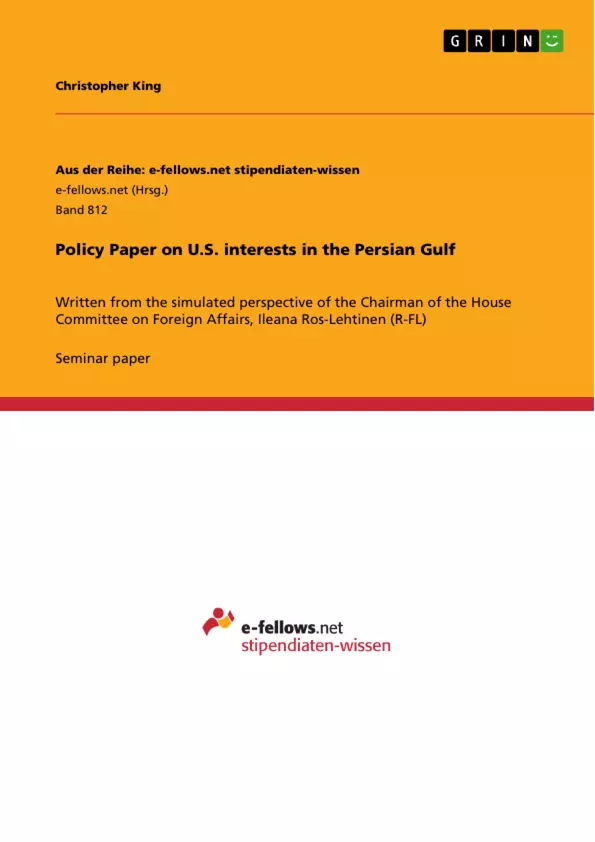The Persian Gulf and its littoral states Iran, Iraq, Kuwait, Saudi Arabia, Bahrain, Qatar, UAE and Oman have witnessed several conflicts over the last decades. They have seen the Iran-Iraq war from 1980-1988 and the two Gulf Wars with U.S. involvement, that made the Persian Gulf a highly volatile region. Historically, the actions taken by America in the region have been driven by mainly two interests: First, ensuring a continued flow of oil exports of the countries and second, preventing a regional hegemon dominating the politics of the Persian Gulf. These interests had been brought to paper with the Carter Doctrine in 1980 in light of the growing assertiveness of the Soviet Union in the Persian Gulf.
Since 9/11, there is also the interest of counterterrorism and today, another power after the Soviet Union tries to seize regional hegemony. The Persian Gulf is now home to a country ruled by a regime that wants to destroy the Israeli state and supports terrorist organizations like Hezbollah and Hamas to further destabilize the region. Furthermore, unrest or even clashes between Sunnis and Shiites in the Persian Gulf countries are possible as they are either majority or minority in a state and oppressed by the antagonistic ruling group. Iran is the main representative of the Shiites, while the GCC countries are ruled by Sunni leaders.
The goal of this paper will be to show awareness of the problems in the Persian Gulf, address U.S. interests in the region, identify threats to these interests and provide policy recommendations in how the United States should pursue its Foreign Policy in the Persian Gulf. As this analysis is written through the lens of the Chairman of the House Committee on Foreign Affairs the Foreign Policy perspective drawn out in this paper shall check the Presidents policy and be ultimately determined by and for the interests and well-being of the American people.
Inhaltsverzeichnis (Table of Contents)
- Introduction
- America’s Principal Interests in the Persian Gulf
- Preventing the spread of terrorism
- Ensuring the continued flow of Arab oil exports
- Security of Israel means containing Iran
- Stability of Persian Gulf Allies
- Main Threats to U.S. Interests in the Persian Gulf
- A destabilized Persian Gulf
- The threat of Iran
- Cuts to military spending
- Roadmap to Protect and Promote U.S. Interests in the Persian Gulf
- Support Persian Gulf allies
- Be straightforward with Iran
- Counterterrorism
- U.S. Military Involvement in the Persian Gulf
- Circumstances of Greater Military Involvement
- Iran trying to close the Strait of Hormuz
- Evidence that Iran is about to complete the atomic bomb
- Recommended Kind of Military Involvement
- Iran trying to close the Strait of Hormuz
- Evidence that Iran is about to complete the atomic bomb
Zielsetzung und Themenschwerpunkte (Objectives and Key Themes)
This policy paper aims to analyze the current political and security landscape in the Persian Gulf, focusing on the United States’ interests in the region, identifying major threats to these interests, and formulating policy recommendations to guide U.S. foreign policy actions. The paper is written from the perspective of the Chairman of the House Committee on Foreign Affairs, highlighting a Congressional viewpoint on the issue.
- Security and stability in the Persian Gulf region
- Counterterrorism and combating the spread of extremist ideologies
- The role of Iran as a destabilizing force in the region
- The importance of the Strait of Hormuz and the flow of oil exports
- The U.S. relationship with its allies in the Persian Gulf
Zusammenfassung der Kapitel (Chapter Summaries)
The paper begins by outlining the key U.S. interests in the Persian Gulf, emphasizing the importance of preventing the spread of terrorism, ensuring energy security through continued oil exports, protecting Israel, and fostering stability among U.S. allies in the region.
It then delves into the major threats facing these interests, specifically highlighting the potential for destabilization due to political turmoil, the threat posed by Iran, and the risks associated with cuts to U.S. military spending.
The paper further explores a roadmap to protect and promote U.S. interests, advocating for a strategy that involves strengthening alliances with GCC countries, adopting a firm and direct approach towards Iran, and dedicating sufficient resources to counterterrorism efforts.
Finally, the paper examines the issue of U.S. military involvement in the Persian Gulf, outlining the circumstances that might necessitate greater military intervention and recommending specific courses of action in response to potential Iranian threats.
Schlüsselwörter (Keywords)
Key terms and concepts central to the paper include U.S. national interests, Persian Gulf security, counterterrorism, Iran, regional stability, energy security, Strait of Hormuz, GCC, Israel, and U.S. military involvement.
- Quote paper
- Christopher King (Author), 2012, Policy Paper on U.S. interests in the Persian Gulf, Munich, GRIN Verlag, https://www.grin.com/document/262775



